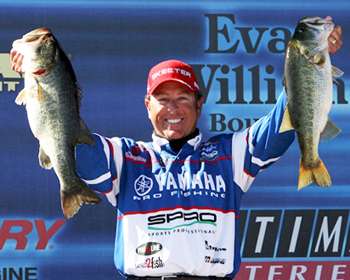
Sure, a shaky head puts bass in the boat. A drop shot can be a prime time limit-getter. And a Carolina rig will allow you to understand the bottom of your favorite lake link a blind person's feeling with a cane.
But those are slow techniques and not always the best way to catch big stringers of bass. While they're certainly used on the Bassmaster Elite Series, for pros who have fewer than three days to dissect a new body of water and try to put together monster limits, they're not always the most effective search tools.
Dean Rojas, who caught the all-time single day weight record by slowly fishing a soft plastic lure, goes to "power fishing" more often than not when he needs to find fish fast. That doesn't change just because he's fishing ultraclear water. In fact, while others may turn to diminutive and superrealistic presentations when you can see a penny in 20 feet of water, Rojas often takes the opposite approach, sticking with his "bubba gear," especially during practice.
"The beauty of fishing clear water that way is that many times you can actually see the fish come up and get the bait before you actually feel it," he explains. "When you're practicing for a tournament, that can be a big help. It lets you can gauge the quality of fish you're around so you can develop a game plan for the actual tournament."
He'll bring out the heavy-duty gear early in the tournament season, typically as soon as the water rises into the low to mid 50s. He'll tie on a crankbait and hit as many main lake and secondary points as the game clock allows. By covering a lot of water, he'll learn where the better concentrations of fish live. With a slower technique, he'd only be able to hit a fraction of the high-potential areas. That doesn't mean he won't slow down once the event starts, but typically he won't do that unless the fish tell him it's necessary.
In the summertime, he'll continue to power fish with big crankbaits and spinnerbaits. A hot weather bass may be lazy, but it will get aggravated just the same as it will during the more moderate temperatures of spring and fall. Rojas recently returned from furnace-hot Lake Mead, where he caught all of his fish on a topwater lure — even as the hot sun baked him and his fellow competitors.
In those conditions, he says, you can sometimes load the boat with a topwater by making long casts off of long tapering points or in an area where you have a deep break.
At Mead, many others went deep as the sun bore down on the desert lake, but Rojas says cloud cover isn't absolutely critical to making the summer power bite work.
"It can help, but it can hurt it, too, because whenever you're in clear water on a sunny day, you'll find shadows around the cover and that positions the fish," he says. "But when you have overcast conditions or low light conditions, bass tend to wander around. They might be a little more aggressive, but they'll also be more scattered, which at times can make them harder to catch."
When he's found a productive area but the bite eventually shuts off, Rojas doesn't immediately turn to finesse when he's after a big limit. Instead, he'll work his way down the water column, from a topwater, to a crankbait, to something that goes a little bit deeper. That preference continues through the fall.
"On the front deck (at that time of year), the first bait I'll have is a Spro Hydro-Pop, then a crankbait, a spinnerbait and probably a follow-up bait for fish that come up and roll on a bait — something like a Fluke (soft jerkbait) or a small shaky head worm," he says. "That way you've covered all of the depths from the very top to the very bottom and all the way in between."
In dirty water, heavy-duty gear is a way of life, but if you put it away when you hit a lake at bathwater clarity, you're leaving lots of quality fish behind — and missing out on a fun way to catch them, Rojas-style.





